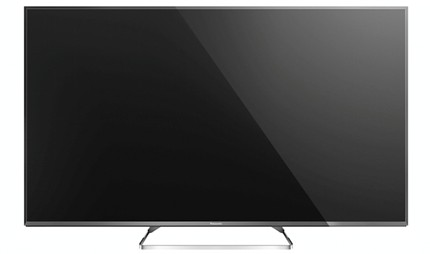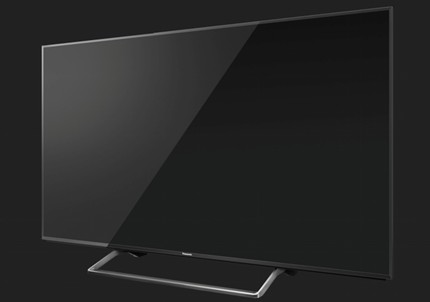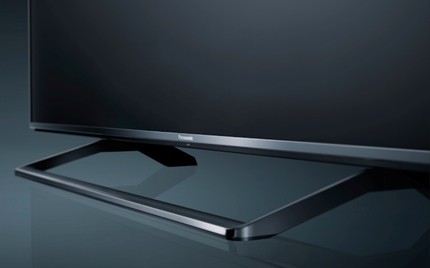Panasonic TC-55CX850U 4K TV Review: Bringing Hollywood Home

You could argue, I guess, that the timing of this review of the Panasonic TC-55CX850U is a bit unfortunate. After all, the attention right now seems to be focussed on a different Panasonic TV: the preposterously brilliant 65CZ950 OLED TV (reviewed in rather glowing terms here).
However, while that OLED model is undoubtedly amazing, it’s still not formally confirmed for a US launch and it costs a vast amount of money; its £8,000 UK price translates to well over $10,000. So for most of us mere mortals the 65CZ950 is nothing more than a pipe dream.
The 55CX850U, on the other hand, is a whole lot more approachable. Sure, its $3,499.99 price is still hardly bargain basement territory, but I’d say it’s not bad at all considering how much the TV has to offer.

This ‘offering’ kicks off with 3840×2160 pixels crammed into its 55-inch screen, meaning, of course, that it’s a 4K (also known as UHD) TV. These days, though, 4K screen resolutions are pretty much de rigueur in the 50-inch and larger section of the TV market, so we’ll have to look elsewhere to explain why the 55CX850U (known as the 55CX802 or 55CX800 in non-US territories) is Panasonic’s premium 55-inch TV for 2015.
Design
It’s an attractive set in a no-nonsense kind of way, managing to keep the frame around the screen to a very narrow minimum, and mounting the TV on an open frame stand design. This helps make sure you focus on the TV’s pictures rather than its bodywork – though I wouldn’t say there’s anything so dazzling about either its design or build quality that it goes far towards explaining the TV’s premium status.
The set’s connections are pretty decent. Highlights include three HDMIs built to the latest spec (so they can handle both high dynamic range content and 4K sources at 60 frames a second); three USBs able to play back a wide range of video, photo and music multimedia formats; and integrated Wi-Fi network connectivity. Again, though, there’s nothing truly premium about this connections array. In fact, many high-end TVs these days offer four HDMIs, not three.
The 55CX850 does step into more premium territory with its smart TV system. This is built around a TV-optimised version of Mozilla’s Firefox OS – and it works brilliantly. Unlike the clunky new Android TV system, which tries to shoehorn what feels like a mobile phone approach into a TV, Firefox TV has clearly been designed from the ground up to suit the needs and interface requirements of a television. The graphics are bold and accessible, the organisation is logical, and best of all it’s almost infinitely customisable, enabling you to create with minimal fuss your own personalised home screen of links to your favourite content.

The amount of content available suggests that Panasonic is benefiting from its new access to the Firefox development community too, with highlights being the UHD-capable versions of Netflix and Amazon’s streaming services.
Good though Firefox TV is, though, it still doesn’t quite explain the 55CX850’s presence at the top of Panasonic’s 2015 LCD TV range – partly because lots of other cheaper Panasonic models also offer the operating system, and partly because there are other rival systems that give it a run for its money on cheaper sets – including, most notably, LG’s excellent webOS platform.
Introducing 4K Pro
It turns out that the real secret to the 55CX850’s premium status lies in something called 4K Pro. This umbrella term covers a combination of hardware and software features all focused, so Panasonic claims, on delivering to consumers pictures that can look absolutely accurate to a director’s original intentions.
On the hardware side the panel inside the 55CX850 combines new wide colour gamut phosphors reckoned to reproduce 93% of the colour range you get in commercial digital cinemas with a new ultra-transmissive design able to produce twice as much brightness per watt of power as a conventional LCD panel. These two hardware abilities should prove helpful in enabling the 55CX850 to deliver the expanded luminance range benefits of high dynamic range (HDR) technology once a future firmware update has unlocked the set’s HDR support.

The software side of 4K Pro is built around a new 4K Studio Master Processor. One of the key components of this is the Accurate Colour Drive: a technology taken from Panasonic’s professional monitors division that creates colours by referring to a so-called 3D look up table system with a huge 8,000 registry points. Many basic LCD TVs, by comparison, only provide around 100 registry points for their colour reproduction to draw on.
Also part of the Studio Master Processor is the Black Gradation Drive. This draws on techniques Panasonic mastered in its plasma days along with 10-bit panel driving to produce 1024 steps of gradation in the screen, which should result in lots more shadow detail than you tend to get with typical LCD TVs. Provided, that is, that the 55CX850 also manages to control its high brightness panel well enough to stop dark scenes becoming spoiled by heavy low-contrast grey misting.
Finally on the advanced processing front there’s something called Dynamic Range Remaster. This is designed to upconvert the standard, non-HDR sources that dominate today’s content into something that actually exploits all the high-brightness, rich-colour screen technologies you’ve coughed up the big bucks for.
The remastering debate
Some AV enthusiasts won’t like the sound of this at all, as it means they’re not seeing pictures being reproduced to exactly the same picture values/standards that they were mastered to for broadcast or Blu-ray/DVD distribution.
If this sounds like you, though, never fear: Panasonic has also included settings that enable you to get the TV to match these ‘traditional’ standards. These include a couple of THX presets, indicating that the TV has managed to pass all the stringent tests – based around the current Rec 709 standard – that THX’s independent picture quality labs could throw at it.

To me, however, it seems a bit daft not to make use of all the screen’s lovely next-gen tech, especially when the Dynamic Range Remaster technology actually works quite sensitively.
Also, while it’s true that Rec 709 is still the standard most content for the home is mastered to, it’s not the standard films are mastered to for the cinema. Instead it’s a greatly compressed, compromised format designed to work within the limitations of the old CRT televisions. So you could argue that video that’s gone through Panasonic’s Dynamic Range Remaster processors actually looks more like a director’s original cinematic vision than pictures which stick slavishly to Rec 709.
Fun (!) though arguments around this area are though, in the end the only thing that really matters is that the TV gives you the choice of how you watch your various sources on it. In fact it boasts a truly huge raft of picture adjustments to help you – or a professional installer – fine tune things to either your own tastes or the specific demands of your room environment.
Picture quality
Having talked a seriously good talk, it would be a bit embarrassing if the 55CX850’s pictures turned out to be anything less than excellent. Fortunately they don’t.
The 4K Pro system makes its presence felt immediately and potently in the gorgeous amount of detail in its pictures. During dark scenes you can see subtle shades of grey and colour that just don’t appear on the vast majority of rival LCD TVs. Colours enjoy seemingly infinitely nuanced blends and tonal shifts. The set’s motion handling does a decent job of keeping movement looking clean, clear and full of resolution without throwing up excessive unwanted side effects (so long as you stick with its lowest power setting).
The net result of all this is that the 55CX850 does a fantastic job of bringing out the full glory of the screen’s native UHD resolution, creating a beautifully precise, natural feel to images that’s so good at times that it makes you feel like you’re seeing favourite old movie scenes for the first time again.
It’s important to stress, too, that while the 55CX850’s sense of total precision is at its keenest with native 4K content, it also remains a strong asset when you’re watching HD sources thanks to some outstanding upscaling processing.

As well as enjoying beautifully subtle tones, the 55CX850’s colours also excel at either looking dramatic and punchy or accurate and restrained, depending on whether you’re using the Dynamic Remastering processing or not. With this in mind it’s a real pity the set’s HDR firmware update hadn’t been finalised in time for me to test some HDR content, as I suspect the set would have handled it quite, maybe even very well.
Backlight issues
Having said that, HDR might also have cast a harsher spotlight on the one chink in the 55CX850’s armour: backlight clouding. Some areas of dark scenes can look unnaturally brighter than others using any of the out of the box presets, leaving you needing to ramp down the TV’s backlight quite dramatically – as low as its 25% level for dark room conditions – if you want dark scenes to look evenly lit and natural.

If you’re still a fan of 3D, you’ll be pleased to hear that the 55CX850 is one of the better 3D TVs I’ve seen. Pictures look detailed and sharp, with minimal crosstalk ghosting noise, and the screen’s mostly impressive contrast performance helps it portray even dark 3D scenes with a good sense of space and depth. Camera pans and fast-moving objects can look a little juddery, but this is a common 3D issue with LCD TVs and actually doesn’t interfere with your 3D experience as much here as it does on many other TVs.
Gaming performance
If you’re a gamer, you’ll be pleased to hear that the 55CX850 works nicely as a gaming monitor. After turning off the majority of its video processing tools I measured the amount of time it takes to render its images at 40ms. This is substantially higher than the sub-10ms figures you’ll get with the best dedicated gaming monitors, and not quite as low as the 30ms figure we ideally look for from a television – but it’s still a decent result. Especially for a 4K TV, where today’s predominantly HD gaming sources have to be remapped to the higher resolution.

In the end I guess the 55CX850 won’t necessarily suit everyone. Certainly there are other TVs out there – especially Samsung’s SUHD models like the JS9500 and JS9000 series, and some of Sony’s 2015 Triluminos models – that deliver more aggressive, eye-catching pictures. Especially once you’re reduced the 55CX850’s brightness to compensate for its backlight clouding issues.
However, if you love watching movies and you consider yourself the sort of AV fan more interested in subtlety, finesse and accuracy than explosive brightness and contrast, a carefully calibrated 55CX850 is uniquely (where LCD technology is concerned) qualified to meet your needs.





